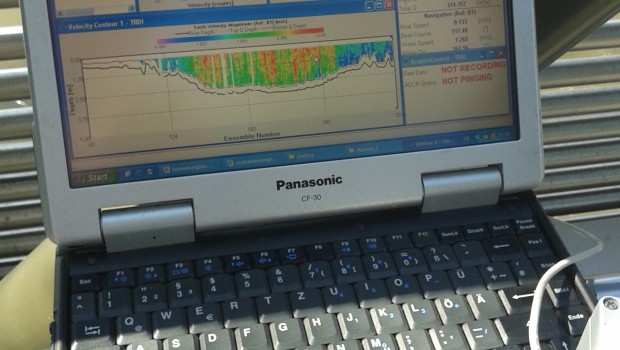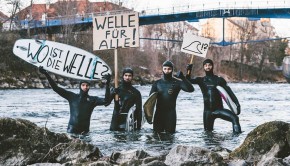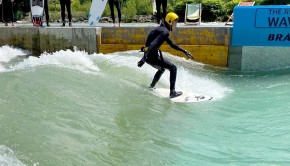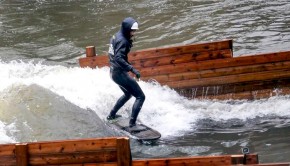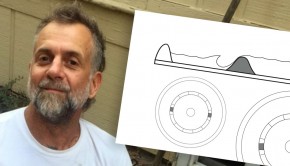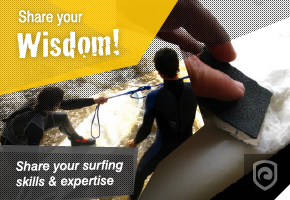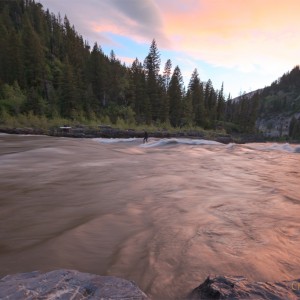Measuring River Waves
Whilst the perfect ocean wave can only be given to us surfers as a gift from mother earth (or sea), man is able to construct stationary waves in rivers or in special basins using water pumps or other kinds of advanced hydrotechnology. But finding the perfect spot for a constructed river wave is not that easy. Again, specialized technology helps us deciding exactly where in a river bed the potential for constructing a surfable wave is at its highest.
This spring a bunch of interested people joined together to measure the bed of the river Mur in Graz, Austria. Surfers, kayakers and wave engineers teamed up with city officials to think about how to manoeuver a small, unmanned and unmotorized scientific plastic trimaran sideways across a river.
The first attempt was to simply attach a rope (approximately 14 meters long) to the boat and guide it from one side of the river to the other while walking on a bridge. But according to the plan developed by Michael Strömer, a wave engineer from Graz, we needed more of these “lines” of measurement. But how do you move a floating device straight across a 40 meter river bed?
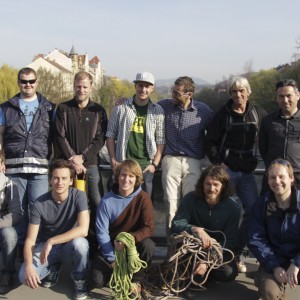 River Measurement Team GrazOur team consisting of city officials, surfers, kayakers and members of the federal energy supply company.© Bernhard Lukas/Philipp Babcicky
River Measurement Team GrazOur team consisting of city officials, surfers, kayakers and members of the federal energy supply company.© Bernhard Lukas/Philipp Babcicky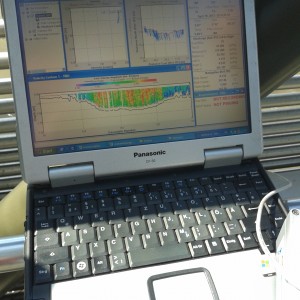 River Measurement SoftwareComputer software showing water flow rates and levels.© Philipp Babcicky
River Measurement SoftwareComputer software showing water flow rates and levels.© Philipp Babcicky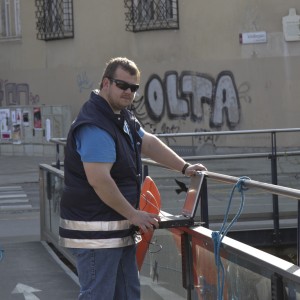 City Official with Computer Laptop© One of our city officials – the guy with cool shades – preparing soft- and hardware.
City Official with Computer Laptop© One of our city officials – the guy with cool shades – preparing soft- and hardware.
After exchanging some thoughts and ideas we finally sticked to this one: First different lengths of ropes (used for rock climbing) were tied together and laid down on the bridge. Then one person held the end of the rope standing on the bridge while the first team went down to the shore with the other end of the rope, attaching it to a tree trunk. As soon as that end of the rope was fixed, the person on the bridge attached a second auxiliary rope to the bridge to hold the middle of the (main) rope firmly attached to the bridge.
The question was, how do you move the boat from one side to the other?
Then the second team moved down to the shore at the other side with the untied end of the main rope. Because it would otherwise consume too much of the rope the second team always pulled the rope slightly down to the shore while the person in the middle of the bridge gently loosened the auxiliary rope until running out of rope. As a (calculated) result the main rope fell into the river and was quickly pulled out with several moves by the second team which fixed the tightened rope to another tree.
Now we had constructed a long rope across the river where the boat could be attached via a return pulley, but how do you move the boat from one side to the other? We needed another (steering) rope! I will spare the details on how we got this one across the river…
Finally to move the boat across the river each of the teams standing on the river shores pulled the steering rope. The desired result was a (surprisingly easy to understand) graphical profile showing a) the depth profile of the river bed and b) the water flow rate at any given point.
Three spots have been measured using this method: The Radetzky spot, the Hauptbrücke spot and the (soon-to-come) “Edegger” spot near the Murinsel in Graz. Totally exhausted I went home only to realize I’d got my first sunburn this year. For what it’s worth.
Measuring river waves photo gallery
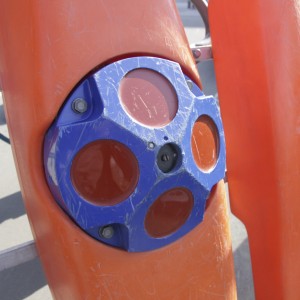 River Measurement Boat BottomRiver boat bottom with sensors for measuring water levels and depth.© Bernhard Lukas
River Measurement Boat BottomRiver boat bottom with sensors for measuring water levels and depth.© Bernhard Lukas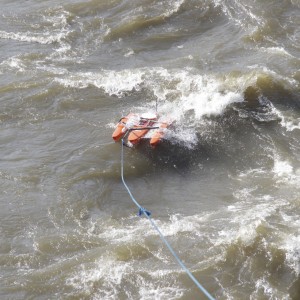 River Measurement BoatThe river boat in action on the river Mur measuring the water levels.© Bernhard Lukas
River Measurement BoatThe river boat in action on the river Mur measuring the water levels.© Bernhard Lukas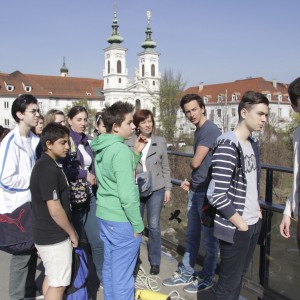 People watching River Measurement in GrazPeople talking to Philipp who helped measuring the river.© Bernhard Lukas
People watching River Measurement in GrazPeople talking to Philipp who helped measuring the river.© Bernhard Lukas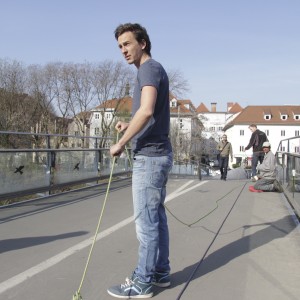 Measuring the RopePrior to hanging the rope it was necessary to measure the length – will we have enough rope?© Bernhard Lukas
Measuring the RopePrior to hanging the rope it was necessary to measure the length – will we have enough rope?© Bernhard Lukas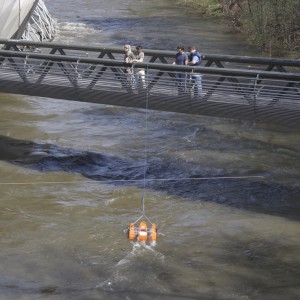 River Boat at the MurinselThe river boat hanging on a rope tied to the Murnsel in Graz.© Bernhard Lukas
River Boat at the MurinselThe river boat hanging on a rope tied to the Murnsel in Graz.© Bernhard Lukas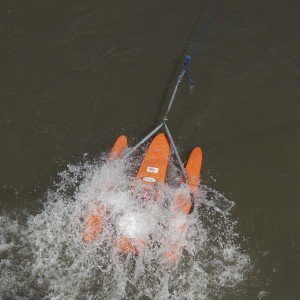 River Boat Duck DiveRiver boat is duck diving – part 1/4© Bernhard Lukas
River Boat Duck DiveRiver boat is duck diving – part 1/4© Bernhard Lukas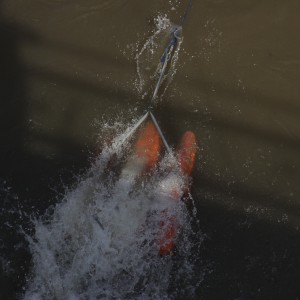 River Boat Duck DiveRiver boat is duck-diving – part 2/4© Bernhard Lukas
River Boat Duck DiveRiver boat is duck-diving – part 2/4© Bernhard Lukas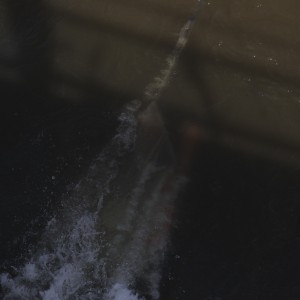 River Boat Duck DiveRiver boat is duck-diving – part 3/4© Bernhard Lukas
River Boat Duck DiveRiver boat is duck-diving – part 3/4© Bernhard Lukas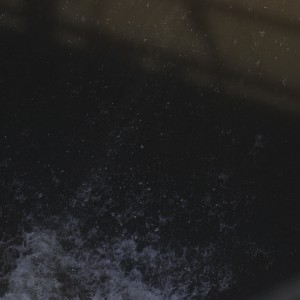 River Boat Duck DiveRiver boat is duck diving – part 4/4© Bernhard Lukas
River Boat Duck DiveRiver boat is duck diving – part 4/4© Bernhard Lukas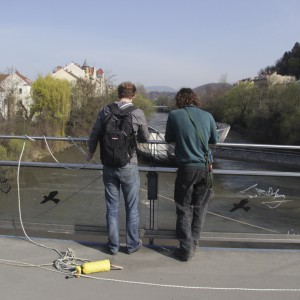 Looking down at the River BoatTwo riversurfers looking down from the middle of the bridge.© Phillip Babcicky
Looking down at the River BoatTwo riversurfers looking down from the middle of the bridge.© Phillip Babcicky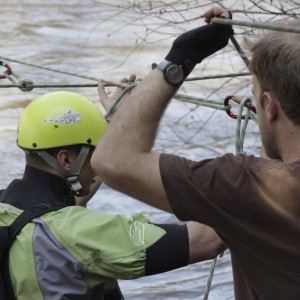 Tightening the KnotsKayakers proceed with fixing the rope to a tree.© Bernhard Lukas
Tightening the KnotsKayakers proceed with fixing the rope to a tree.© Bernhard Lukas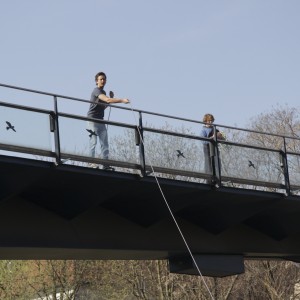 Hanging the RopeOur team in the middle of the bridge taking care of the rope.© Bernhard Lukas
Hanging the RopeOur team in the middle of the bridge taking care of the rope.© Bernhard Lukas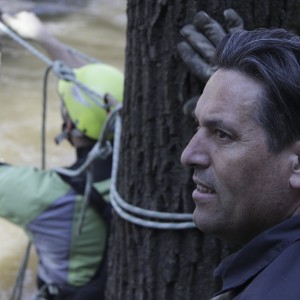 Watching the ProgressOur city official watches the preparation for the boat traversing the river.© Bernhard Lukas/Philipp Babcicky
Watching the ProgressOur city official watches the preparation for the boat traversing the river.© Bernhard Lukas/Philipp Babcicky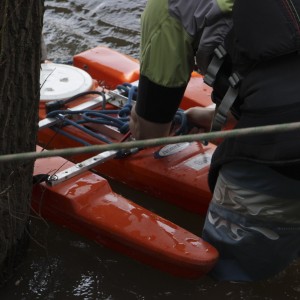 Finishing the KnotsOne of our kayakers fixing the rope to the boat.© Bernhard Lukas/Philipp Babcicky
Finishing the KnotsOne of our kayakers fixing the rope to the boat.© Bernhard Lukas/Philipp Babcicky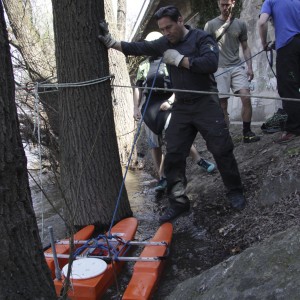 Letting the Boat to the WaterLetting the boat into the river guided by the hands of our city official.© Bernhard Lukas/Philipp Babcicky
Letting the Boat to the WaterLetting the boat into the river guided by the hands of our city official.© Bernhard Lukas/Philipp Babcicky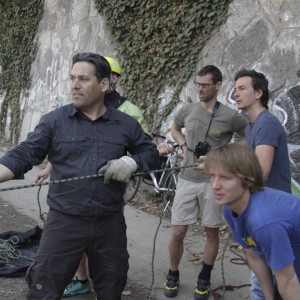 Pulling the RopeOur team pulling the rope.© Bernhard Lukas
Pulling the RopeOur team pulling the rope.© Bernhard Lukas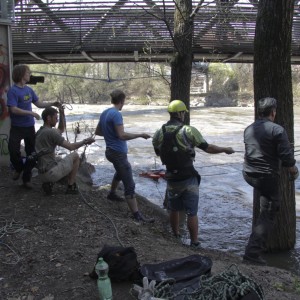 Pulling the RopeOur team pulling the rope.© Philipp Babcicky
Pulling the RopeOur team pulling the rope.© Philipp Babcicky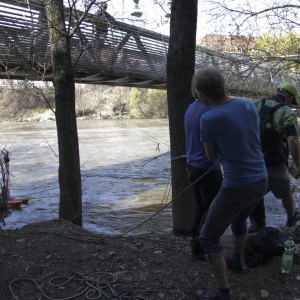 Pulling the RopeOur team pulling the rope.© Philipp Babcicky
Pulling the RopeOur team pulling the rope.© Philipp Babcicky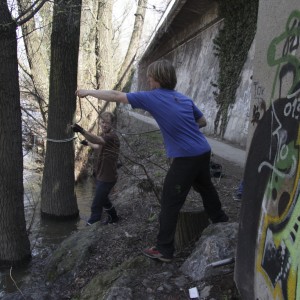 Talking to the NeighboursTeam on one river shore talking to the team on the other side.© Bernhard Lukas
Talking to the NeighboursTeam on one river shore talking to the team on the other side.© Bernhard Lukas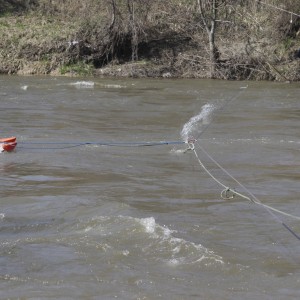 River Boat Measuring the RiverOur small river boat guided by the main rope and moved from left to right with a steering rope.© Bernhard Lukas
River Boat Measuring the RiverOur small river boat guided by the main rope and moved from left to right with a steering rope.© Bernhard Lukas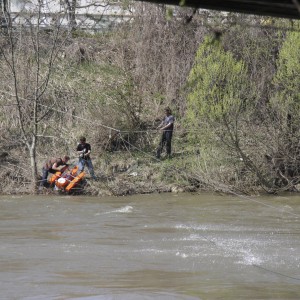 Boat on the Other SideFinally our boat reached the other side of the river.© Bernhard Lukas
Boat on the Other SideFinally our boat reached the other side of the river.© Bernhard Lukas

